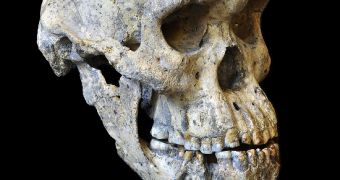Back in 2005, a 1.8-million-year-old fossilized skull belonging to an early human was discovered at an archaeological site in Georgia. Fast forward several years, and this skull seems likely to rewrite the history of the human species.
Thus, a study published in yesterday's issue of the journal Science details how, after carefully inspecting this skull's anatomical particularities, researchers reached the conclusion that three early human species previously said to be different from one another might have in fact been just one.
The three species in question are Homo habilis, Homo rudolfensis and Homo erectus, and new evidence suggests that they could be subsumed under Homo erectus.
Nature tells us that, in their paper, scientists detail that this skull was unearthed at the site of a medieval hilltop town by the name of Dmanisi.
According to Marcia Ponce de León with the Anthropological Institute and Museum in Zurich, Switzerland, “[It] is the most complete skull of an adult from this date.”
The early human remain, nicknamed “skull 5” by the people studying it due to the fact that it was found alongside four other skulls, has a volume of roughly 550 cubic centimeters, meaning that it is three times smaller than the average modern human's skull.
The hominin's face appears to have been fairly large and protruded. What's more, this early human appears to have had large teeth and a rather massive jaw.
Live Science tells us that, up until now, no other Homo remains unearthed in various regions of the world have been documented to display this collection of features.
“Had the braincase and the face of Skull 5 been found as separate fossils at different sites in Africa, they might have been attributed to different species,” neurobiologist Christoph Zollikofer with the Anthropological Institute and Museum in Zurich, Switzerland explained in a statement.
Despite looking different from the other four skulls unearthed at this site, there is little doubt that the 1.8-million-year-old skull belonged to an individual that was part and parcel of the same population.
“It’s tempting to publish them as different species. Yet we know that these individuals came from the same location and the same geological time, so they could, in principle, represent a single population of a single species,” Christopher Zollikpfer says.
These findings indicate that what scientists have previously documented as differences between species might have actually been differences between individuals.
As explained on the official website for the University of Zurich, “The African fossils from around 1.8 million years ago likely represent representatives from one and the same species, best described as 'Homo erectus'.”
Furthermore, “This would suggest that «Homo erectus» evolved about 2 million years ago in Africa, and soon expanded through Eurasia – via places such as Dmanisi – as far as China and Java, where it is first documented from about 1.2 million years ago.”

 14 DAY TRIAL //
14 DAY TRIAL //